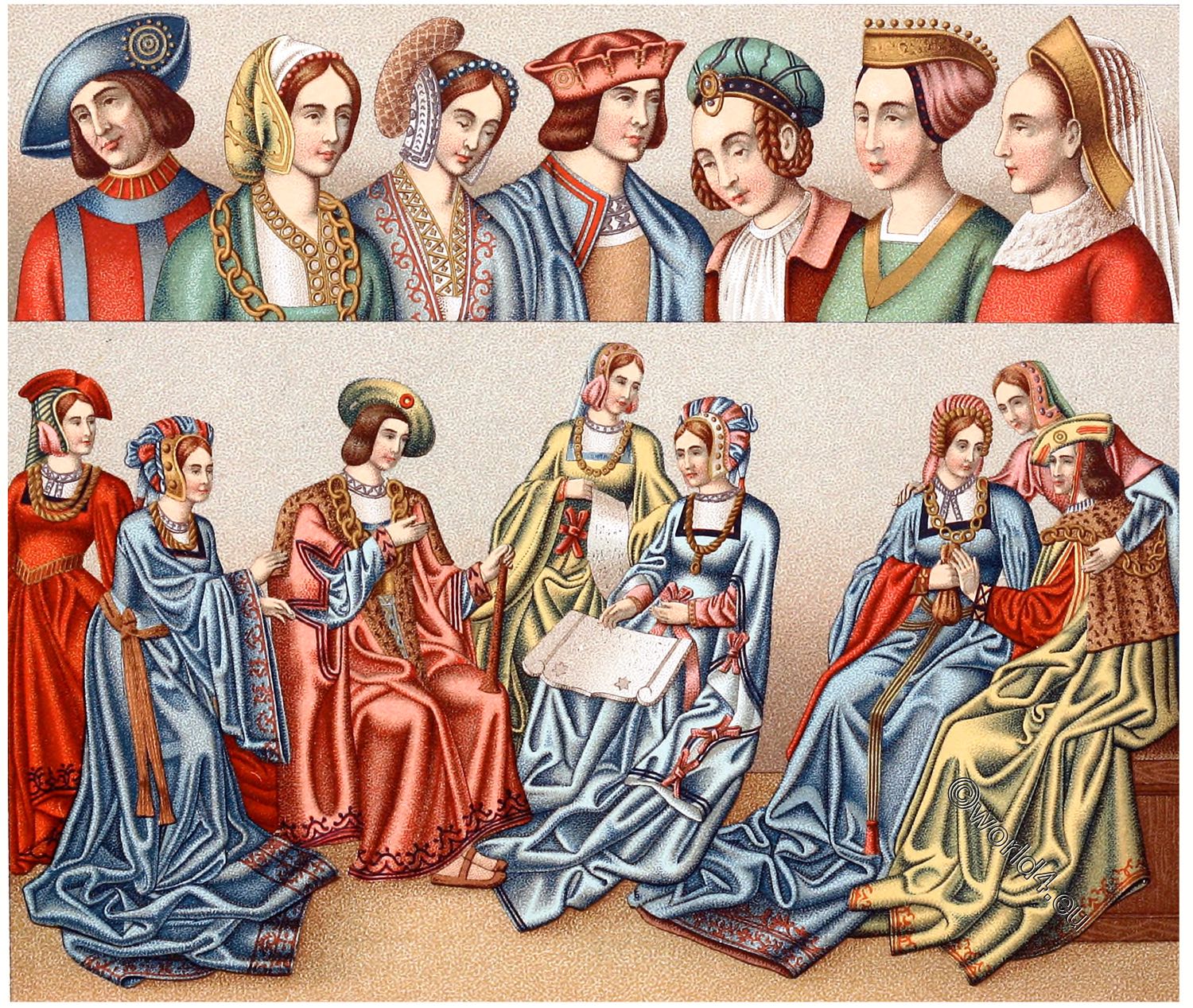
1 2 3 4 5 6
7 8 9 10 11
FRANCE. BOURGEOIS COSTUMES. PARTS OF WOMEN’S CLOTHING, 1485-1510.
EUROPA. XV. XVI. CENTURY
The Flemish carpet fabrics of the almost exclusive treatment of mythological motifs are particularly important for the current fashions of the time. They are of the same importance for the XVth and XVIth centuries as the tapestries of Lebrun were for the age of Louis XIV.
The costumes reproduced here are still under the influence of Anne of Brittany, the wife of Charles VIII, after whose death the intrusion of Italian fashions only became apparent.
Between 1470 and 1475 the high pointed hoods (Hennin) disappear. Around 1488 a headdress is generally worn, consisting of the coiffe, a kind of beguine made of white silk embroidered with gold, the templette, a front piece decorated with gold, pearls or chains that frames the face, and the chaperon, a kind of dark veil that falls over the shoulders on both sides.
At the end of the XV century the woman wears a kind of slipper made of velvet or silk, over it a black leather shoe, trousers or stockings made of the finest cloth with gold-embroidered garters, a shirt made of Dutch canvas with long sleeves. The skirt (cotte or corset; with narrow sleeves and a wide neckline is worn long at first, after 1488 it only reaches to the ankles. A breast cloth (gorgerette) of fine silk fabric or lace reaches under the bodice to the base of the neck.
The transformation of the male costume took place much faster than that of the female costume. The hair has been worn long without exception since 1505. The headgear is a mortar-shaped hat, the open brim of which is decorated with an agraffe. The cap becomes a toque according to Florentine and Milanese patterns.
Instead of the long robes, especially younger people prefer the jacket open on the chest or the attached doublet with a small coat. The difference between haute and bas de chausses, between short puff pants and stockings made of other fabrics also appears at this time. The shoes show a wide tapered shape after the toes.
- No. 2 – Joan of France, daughter of Louis XI, first wife of Louis XII, 1464-1504. she wears the escoiffion à cornes of linen or muslin, which has been out of fashion since 1480.
- No. 6 – Catherine of Aragon, Queen of England, wife of Henry VIII – 1483-1536
- No. 7 wears the cloak with the wide collar and the Italian toque.
- No. 10 is a messenger who receives or hands over a sealed parcel. He wears a kind of heraldic dalmatics with embroidered coats of arms. The short staff in his left is the messenger’s badge.
- No. 11 carries a long torch, as used at festivals. His clothing consists of a short fur skirt with a collar falling broadly over his back. The cut of the hair is characteristic of the time.
The other figures of the table do not offer any special peculiarities. In nos. 4 and 8 the Italian taste is noticeable.
No. 2 and 6 after paintings in the possession of Mr. Arondel.
Nos. 1, 3, 4 and 5 after tapestries from the collection of Mr. Adrien Dubouché.
Nos. 7, 8, 9, 10 and 11 after carpets of Flemish manufacture depicting the Triumph of Beatrice and from the Roman de la Rose, owned by Mr Richard Wallace.
Cf. Quicherat, Histoire du costume en France. – Viollet-le-Duc, Dictionnaire raisonne du mobilier français.
Source: History of the costume in chronological development by Albert Charles Auguste Racinet. Edited by Adolf Rosenberg. Berlin 1888.
Related
Discover more from World4 Costume Culture History
Subscribe to get the latest posts sent to your email.






